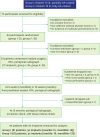Randomized controlled clinical trial of 2 types of hydroxyapatite-coated implants on moderate periodontitis patients
- PMID: 27800216
- PMCID: PMC5083817
- DOI: 10.5051/jpis.2016.46.5.337
Randomized controlled clinical trial of 2 types of hydroxyapatite-coated implants on moderate periodontitis patients
Abstract
Purpose: The aim of this study was to compare and analyze the peri-implant tissue conditions and prospective clinical outcomes associated with 2 types of hydroxyapatite (HA)-coated implants: (1) fully HA-coated implants and (2) partially HA-coated implants with resorbable blast medium on the coronal portion of the threads.
Methods: Forty-four partially edentulous patients were randomly assigned to undergo the placement of 62 HA-coated implants, and were classified as the control group (partially HA-coated, n=30) and the test group (fully HA-coated, n=32). All patients had chronic periodontitis with moderate crestal bone loss around the edentulous area. The stability and clinical outcomes of the implants were evaluated using the primary and secondary implant stability quotient (ISQ), as well as radiographic, mobility, and peri-implant soft tissue assessments around the implants. The Wilcoxon signed-rank test and the Mann-Whitney test were used to evaluate differences between and within the 2 groups, with P values <0.05 considered to indicate statistical significance.
Results: The fully HA-coated implants displayed good retention of crestal bone, and insignificant differences were found in annual marginal bone loss between the 2 types of HA-coated implants (P>0.05). No significant differences were found in the survival rate (group I, 100%; group II, 100%) or the success rate (group I, 93.3%; group II, 93.8%). The fully HA-coated implants also did not significantly increase the risk of peri-implantitis (P>0.05).
Conclusions: The fully HA-coated implants did not lead to an increased risk of peri-implantitis and showed good retention of the crestal bone, as well as good survival and success rates. Our study suggests that fully HA-coated implants could become a reliable treatment alternative for edentulous posterior sites and are capable of providing good retention of the crestal bone.
Keywords: Dental implants; Durapatite; Osseointegration; Periodontitis; Surface properties.
Conflict of interest statement
No potential conflict of interest relevant to this article was reported.
Figures



Similar articles
-
Periodontal-type measurements associated with hydroxyapatite-coated and non-HA-coated implants: uncovering to 36 months.Ann Periodontol. 2000 Dec;5(1):56-67. doi: 10.1902/annals.2000.5.1.56. Ann Periodontol. 2000. PMID: 11885182 Clinical Trial.
-
Immediate and early loading of hydrothermally treated, hydroxyapatite-coated dental implants: a 7-year prospective randomized clinical study.Int J Implant Dent. 2021 Mar 10;7(1):21. doi: 10.1186/s40729-021-00299-x. Int J Implant Dent. 2021. PMID: 33751297 Free PMC article. Clinical Trial.
-
Effects of guided bone regeneration around commercially pure titanium and hydroxyapatite-coated dental implants. II. Histologic analysis.J Periodontol. 1997 Oct;68(10):933-49. doi: 10.1902/jop.1997.68.10.933. J Periodontol. 1997. PMID: 9358360
-
Coated vs uncoated implants: bone defect configurations after progressive peri-implantitis in dogs.J Oral Implantol. 2014 Dec;40(6):661-9. doi: 10.1563/AAID-JOI-D-12-00089. J Oral Implantol. 2014. PMID: 23289839
-
Effects of guided bone regeneration around commercially pure titanium and hydroxyapatite-coated dental implants. I. Radiographic analysis.J Periodontol. 1997 Mar;68(3):199-208. doi: 10.1902/jop.1997.68.3.199. J Periodontol. 1997. PMID: 9100194
References
-
- Porter JA, von Fraunhofer JA. Success or failure of dental implants? A literature review with treatment considerations. Gen Dent. 2005;53:423–432. - PubMed
-
- Sun L, Berndt CC, Gross KA, Kucuk A. Material fundamentals and clinical performance of plasma-sprayed hydroxyapatite coatings: a review. J Biomed Mater Res. 2001;58:570–592. - PubMed
-
- Filiaggi MJ, Coombs NA, Pilliar RM. Characterization of the interface in the plasma-sprayed HA coating/Ti-6Al-4V implant system. J Biomed Mater Res. 1991;25:1211–1229. - PubMed
-
- Spoerke ED, Murray NG, Li H, Brinson LC, Dunand DC, Stupp SI. A bioactive titanium foam scaffold for bone repair. Acta Biomater. 2005;1:523–533. - PubMed
LinkOut - more resources
Full Text Sources
Other Literature Sources
Research Materials

